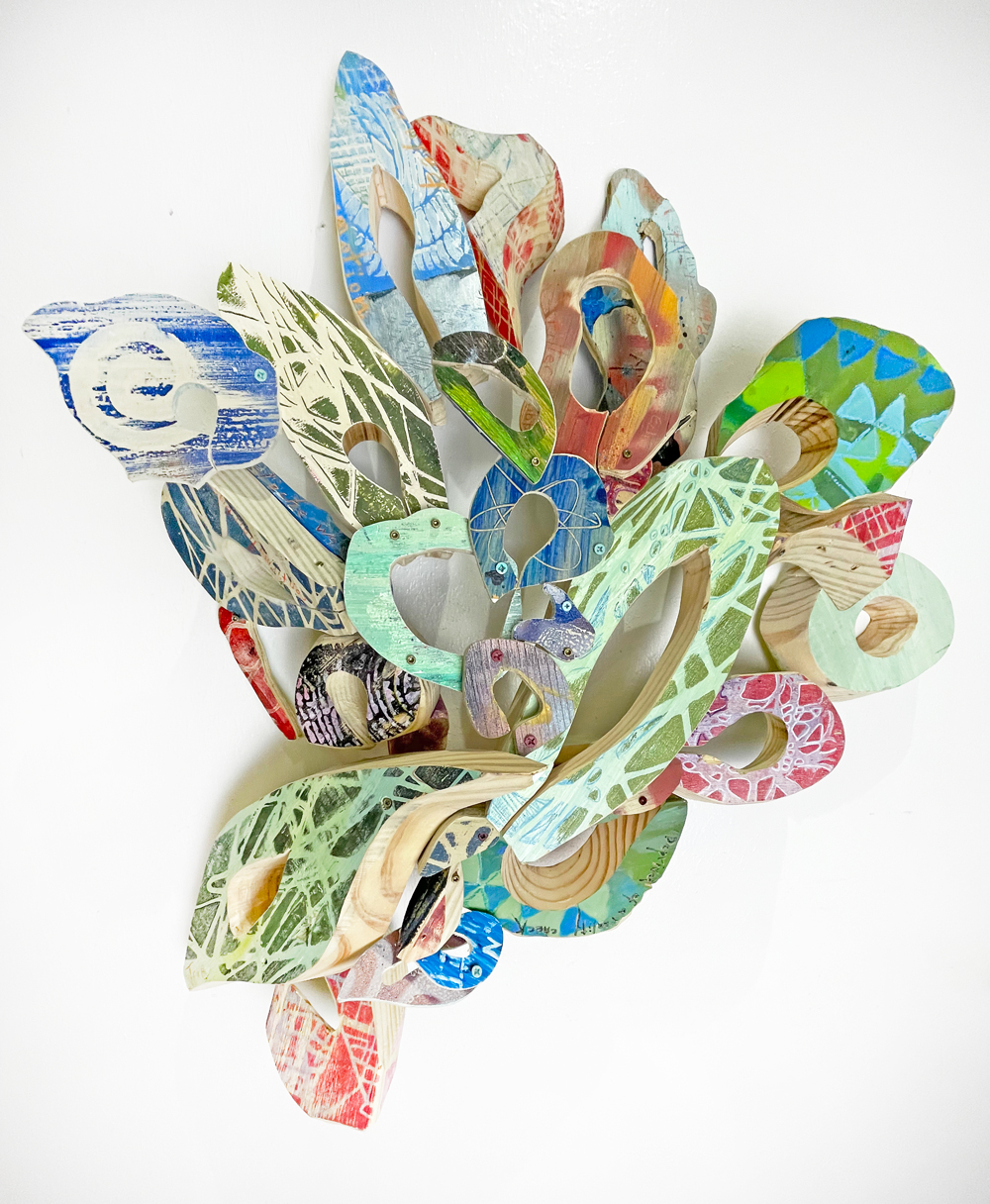
27″x25″x5″; reclaimed wood, acrylic paint, oil pastel; 2024. Courtesy of the artist.
SYMPOSIUM AT KOLAJ FEST NEW ORLEANS 2025
Paper, Wood, Metal, & Everything Else: Materials and Collage
EVENT WEBSITE | REGISTER
Kolaj Fest New Orleans is a multi-day festival and symposium about contemporary collage and its role in art, culture, and society, 25-29 June 2025. Visit the website to learn more, see an overview of the program, and register to attend.
Materials matter, particularly in collage where the material is never neutral. That magazine fragment, that clipping from a book, that piece of found cardboard has a life and a history and when we use it in our artwork, when we appropriate that piece of culture, we bring into our artwork its life and history. That is part of what makes collage magic.
During the Symposium at Kolaj Fest New Orleans, we will hear from Julie Glass, Julie Eisenberg Pitman, Robin Sanford Roberts, Flanzella, and Cindy Green; each of whom have a specific material practice about what they use, how they use it, and why it is important to them. They will speak about collecting and using paper, but also wood, metal, fabric, and other things. And then, if you want, we can talk about glue.
Julie Glass (image top) is interested in the intersection of materials, processes, visuals, emotions and concepts. Conceptually speaking, the Amite, Louisiana artist draws inspiration from quantum physics. “Particles can be anywhere at any time, so it is theorized that parallel universes could exist.” She wrote, if so “there are infinite possibilities and we could live an infinite number of lives. If everyone knew they might live every other person’s life, empathy would abound. Every action, every thought, can lead in a new direction and have wildly varying consequences.” Materially speaking, Glass paints, prints, decoupages and writes on reclaimed wood, and then cuts and carves the pieces using various saws and tools. This process results in colorful, odd shaped pieces that Glass assembles into dynamic sculptures that return the fragment into a unified whole, and yet something radically different.
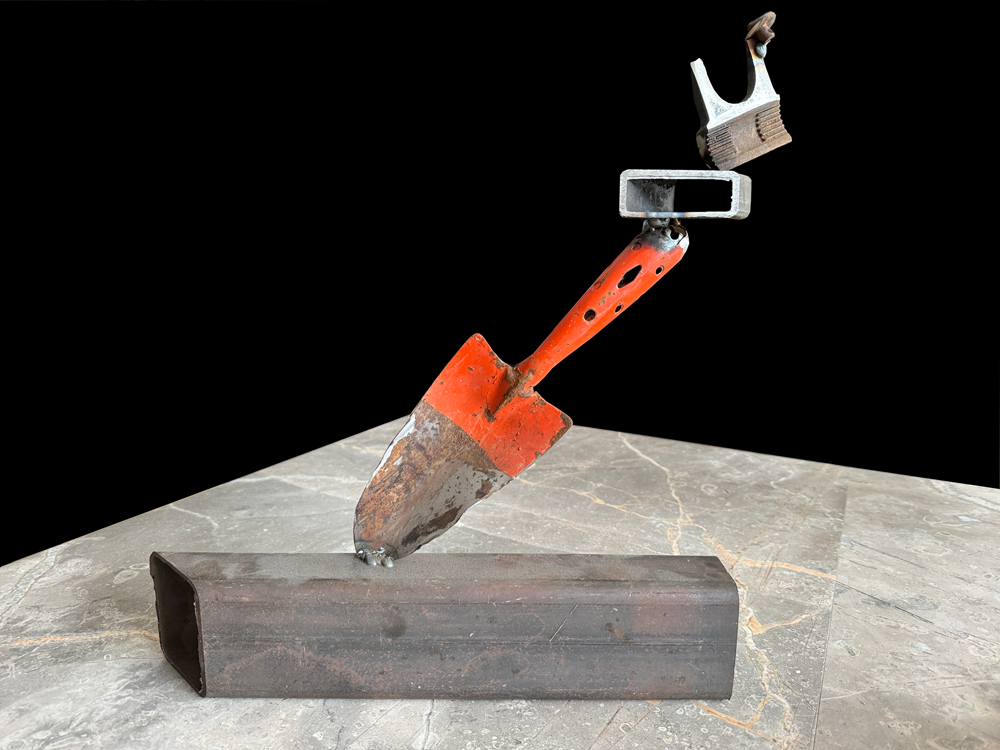
14.25″x16″x2″; scrap steel, the artist’s father’s trowel. Courtesy of the artist.
When her father passed away, Brooklyn, New York artist Julie Eisenberg Pitman found herself drawn to the “material remnants of his life.” She wrote, “These everyday objects revealed fragments of his life, quiet flashes in the periphery of his personal drama. I began to wonder: where does the junk go, the things no one truly understands? On a deeper level, in his absence, I felt a strong need to belong, to connect, and to understand myself through him.” This led Pitman to her “Puddles of Nothing” project where she used welding to make assemblages of her father’s tools and other objects. “Unlike [paper] collage, welding is permanent, harder to undo. So, I breathe deeply, lay out the steel, and shut everything else out. It’s all an experiment, a surrender. The assemblages in ‘Puddles of Nothing’ transform what is discarded into something new, casting representations of the past into the present.” Pitman will present examples of this body of work and speak about her process.
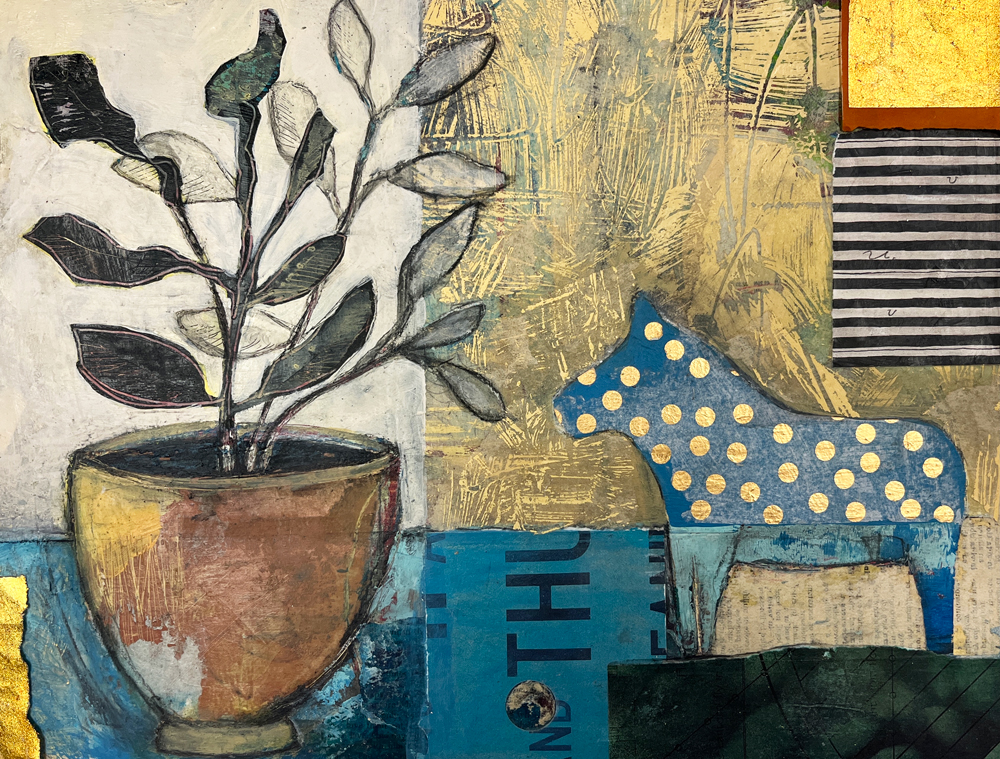
11″x14″; paper and paint; 2024. Courtesy of the artist.
The artwork of San Diego, California artist Robin Sanford Roberts “revolves around exploring fragments from the past—uncovering their stories and weaving them into new compositions.” She wrote, “I am drawn to materials with history, finding beauty in their worn edges and faded textures, and giving these remnants a renewed life through my artistic process.” She also monoprints her own unique papers using a gelli plate. Roberts will present her artwork and offer strategies for creating or collecting papers for collage.
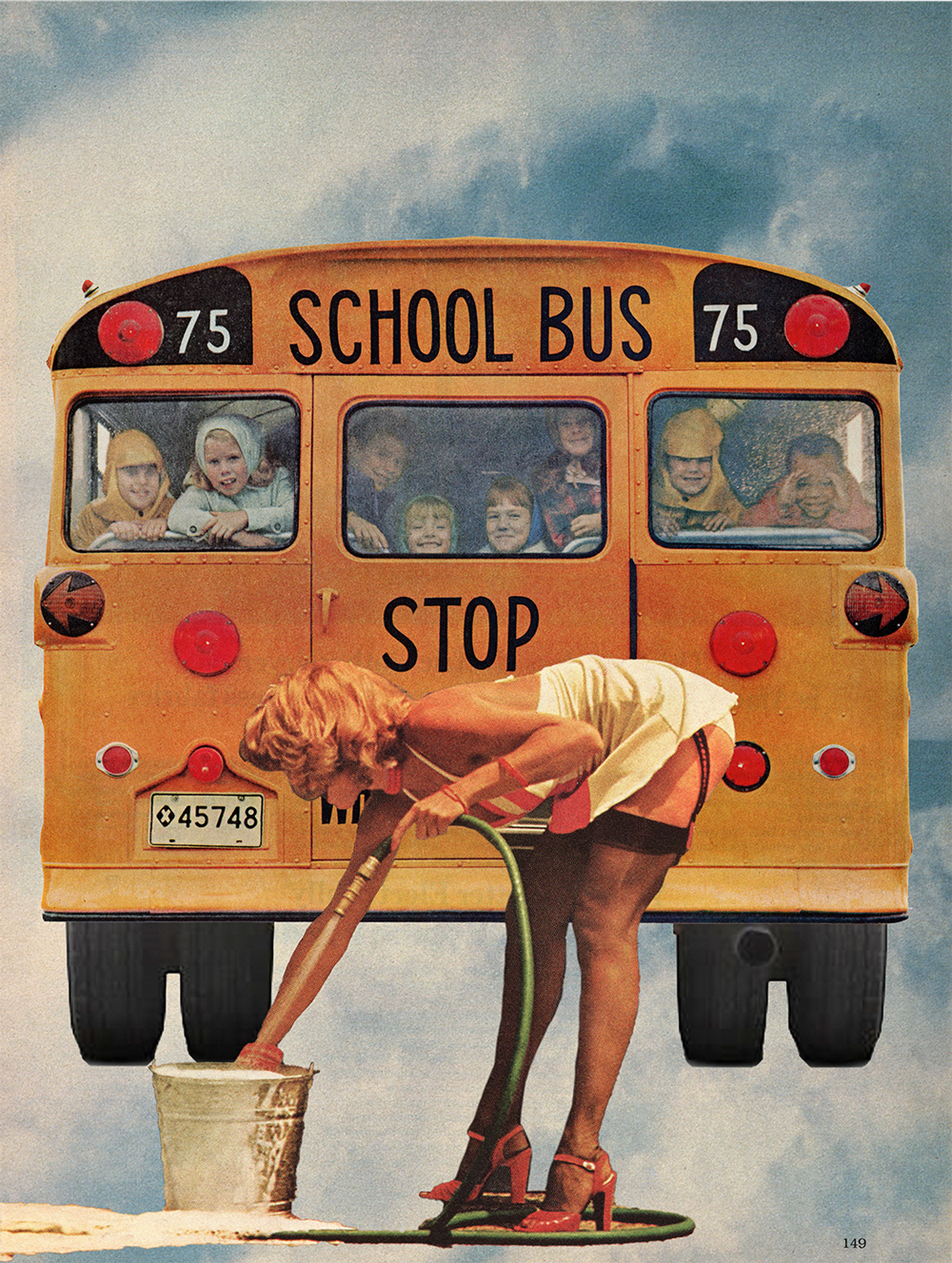
13″x16″; vintage magazine; 2025. Courtesy of the artist.
Like many collage artists, Dallas, Texas collagist Flanzella draws from vintage magazines which she sees “just as ephemera, but as a living, evolving material for storytelling and social reflection.” In this presentation, the artist will consider the use of these materials, their political and cultural implications and how advertisements, editorial photography, and illustrations from past decades gain new meaning when recontextualized in contemporary art. She asks, “Why does nostalgia resonate so deeply with modern audiences? How does collage act as a vehicle for critique, transforming outdated ideals into commentary on today’s world?” She offers “practical strategies for building their own archive of vintage clippings and preserving their fragile pages with proper adhesives, UV protection, and conservation techniques.”
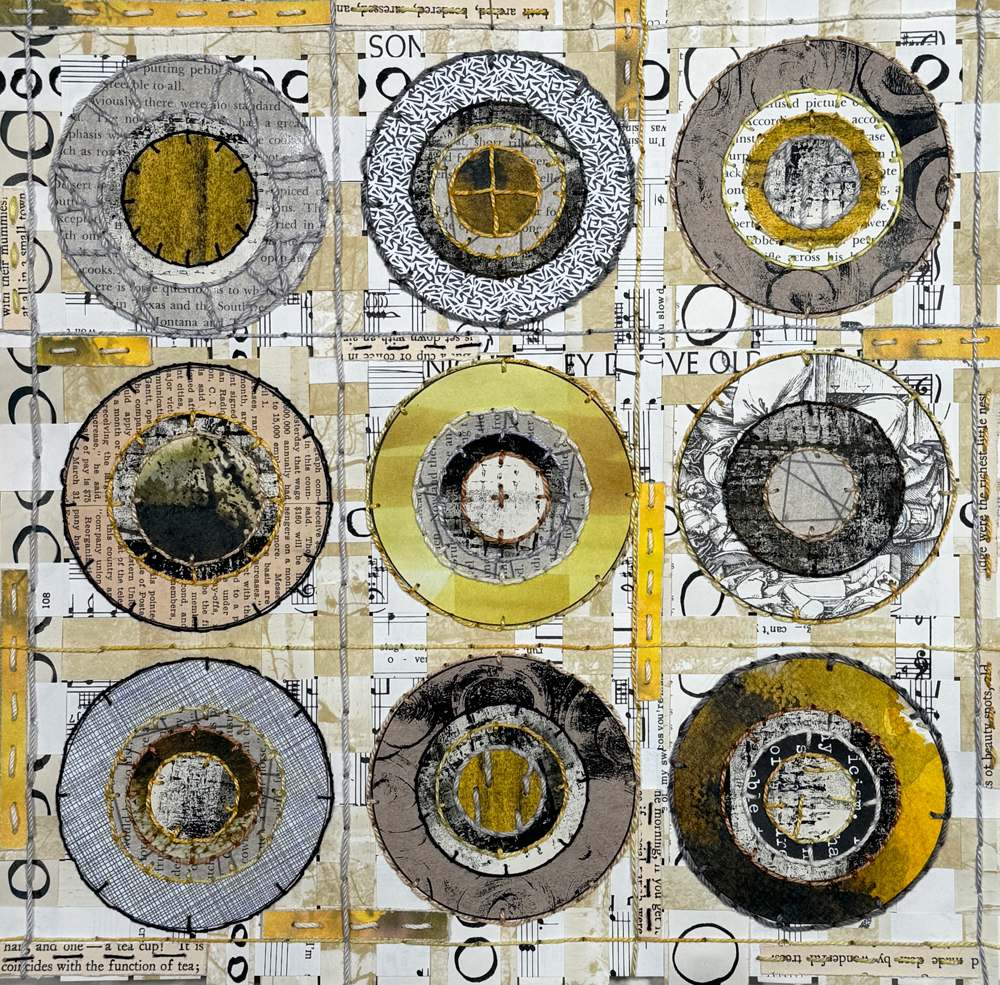
12″x12″; woven, painted, inked and found papers with embroidery; 2025. Courtesy of the artist.
Tucson, Arizona artist Cindy Green makes collage using found and created paper, fabric, prints of her street photographs. Sometimes she weaves the background or adds machine and hand stitching and embellishes the works with paint, pencil, pastel, oil markers. The resulting artworks offer the viewer a rich sense of material where the occasional bright color pops against earthy tones like a flower in the desert. “I love to weave paper for backgrounds. My favorite subjects are still lifes and geometric forms of which circles are my favorite,” wrote the artist. “I’ve always been into sustainability and reuse and there is nothing that might not end up in a collage–a soap wrapper, a baguette bag, a print of one of my photographs, old newspapers, magazine pages, old books, maps, my partner’s art discards, etc. Texture plays a big part in my artistic choices.” Green will speak about her artist practice and the variety of materials and techniques she uses.
Symposium at Kolaj Fest New Orleans
Symposium sessions at Kolaj Fest New Orleans bring together a group of artists who speak about a central theme. Artists, writers, academics, and curators present slideshows which are followed by a Question & Answer period.
ABOUT THE PRESENTERS
Julie Glass is a sculptor working in wood, steel, Plexiglas and textiles, whose work was most recently part of the Midsouth Sculpture Alliance 2025 juried exhibition in Oxford, Mississippi. She has exhibited at the Ogden Museum of Southern Art, the New Orleans Contemporary Art Center, the Aquarium Gallery, the Good Children Gallery, and the Louisiana Jazz and Heritage Museum in New Orleans; the Glassell Gallery, the Carey Saurage Arts Center and the Louisiana Art and Science Museum in Baton Rouge; the Masur Museum in Monroe, the Alexandria Museum of Art; the Louisiana State Exhibit Museum (solo show), the Norton Art Gallery, ArtSpace (solo show and group shows), and the Marlene Yu Museum and other locations in Shreveport. She has completed a residency at the Kallenberg Tower. Her public art is on permanent installation at the Shreveport Regional Arts Council. The artist lives and works in Amite, Louisiana. Learn more at www.julieglassart.com.
Julie Eisenberg Pitman is an artist living and working in Brooklyn, New York. She holds a BFA in Design from The University of Michigan. She studied at the Studio Arts College International (SACI) in Florence, Italy. Eisenberg Pitman exhibits both nationally and internationally, including Tokyo Digital Billboards, The Superchief Gallery, New York City; Palazzo Albrizzi, Venice, Italy; Alexandria Museum of Art, Louisiana; The Copeland Gallery, London, Verum Ultimum Art Gallery, Oregon; Sturt Haaga Gallery, California, and has been featured in CherryBombe and Musée Magazine. Her journey with the Arctic Circle Residency is shaping new directions in her work with her photographs of arctic kelp. Learn more at www.julieeisenbergpitman.com and on Instagram @eisenbergpitman.
Robin Sanford Roberts is an artist and theatrical scenic designer working in three dimensional sculpture, models and mixed media. She has designed scenery for multiple theatres including the Old Globe Theatre, Denver Center Theatre Company, Portland Center Stage and Broadway. She holds a degree in Architecture from Louisiana State University and a MFA in Scenic Design from the University of California, San Diego. She also studied at the Ecole Des Beaux Arts, Fontainebleau and at Sir John Cass School of Art, London Polytechnic. Roberts teaches and designs scenery for the Department of Theater at the University of San Diego and has a studio practice at Art on 30th in San Diego. She recently was awarded the Denis Diderot grant for an International Artists & Writers Residency at Chateau d’Orquevaux in France. Learn more at the Kolaj Magazine Artist Directory, www.robinsanfordrobertsart.com, and on Instagram @mizrobin.
Flanzella studied Multimedia & Communications with a focus in Studio Art at McMaster University. Originally from Toronto, Flanzella lives and works in Dallas, Texas. Learn more at the Kolaj Magazine Artist Directory and www.flanzella.com.
Cindy Green splits her time between Tucson, Arizona; Ennis, Montana; and New Orleans. For decades, she has been creating multimedia pieces using collage. The artist has always been into sustainability and reuse. Her works have included a soap wrapper, a baguette bag, a print of one of her photographs, old newspapers, magazine pages, old books, maps, her partner’s art discards, and fabric.
Kolaj Fest New Orleans is a multi-day festival and symposium about contemporary collage and its role in art, culture, and society, 25-29 June 2025. Visit the website to learn more, see an overview of the program, and register to attend.
